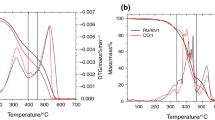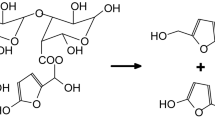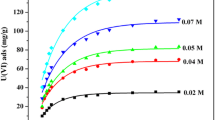Abstract
A physicochemical characterization of natural raw resin material was evaluated and reported. The studied material is a natural resin, a natural product from pinus halepensis trees which is collected from the forests of Chalkidiki region of North Greece. The plurality of this product combined with its special property of removing water from commercial liquid fuels commands the detailed physicochemical characterization of this material. In particular, various techniques, such as water adsorption at 22 °C, thermogravimetric analysis, differential scanning calorimetry, Fourier transform infrared spectroscopy and X-ray diffraction, were used in order to evaluate the structural and surface properties of the material. The water adsorption isotherm was also measured and fitted using the Guggenheim, Anderson and De Boer model in order to correlate the water activity characteristics. In addition, the kinetics of the adsorption was also fitted with good accuracy using the exponential Chapman model. Furthermore, as the results show, the natural resin presents good thermal characteristics. Finally, the studied material presents efficient water adsorption properties, up to 246.8 mmol/g, and it can be proposed as a promising dehydration material.









Similar content being viewed by others
References
P.R. Lewis, C. Gagg, Forensic Polymer Engineering: why Polymer Products Fail in Service (Woodhead/CRC Press, Boca Raton, Florida, USA, 2010)
S. Mecking, Nature or petrochemistry? Biologically degradable materials. Angew. Chem. Int. Ed. 43, 1078–1085 (2004)
V. Sharma, P.P. Kundu, Addition polymers from natural oils—a review. Prog. Polym. Sci. 31, 983–1008 (2006)
I. Jantam, A.S. Ahmad, Oleoresins of three Pinus species from Malaysian pine plantations. ASEAN review of biodiversity and environmental conservation (1999)
K.C. Silva Rodrigues-Corrêa, J.C. Lima, A.G. Fett-Neto, Pine oleoresin: tapping green chemicals, biofuels, food protection, and carbon sequestration from multipurpose trees. Food Energy Secur. 1, 81–93 (2012)
M.J. Lombardero, M.P. Ayres, P.L. Lorio, J.J. Ruel, Environmental effects on constitutive and inducible resin defenses of Pinus taeda. Ecol. Lett. 3, 329–339 (2000)
Z. Wang, M.M. Calderon, M.G. Carandang, Effects of resin tapping on optimal rotation age of pine plantation. J. For. Econ. 11, 245–260 (2006)
J.J.W. Coppen, J.M. Robinson, L.J. Mullin, Composition of xylem resin from five Mexican and Central American Pinus species growing in Zimbabwe. Phytochemistry 27, 1731–1734 (1998)
J.J.W. Coppen, C. Gay, D.J. James, J.M. Robinson, N. Supriana, Variability in xylem resin composition amongst natural populations of Indonesian Pinus merkusii. Phytochemistry 33, 129–136 (1993)
S. Turtola, A.M. Manninen, R. Rikala, P. Kainulainen, Drought stress alters the concentration of wood terpenoids in scots pine and Norway spruce seedlings. J. Chem. Ecol. 29, 1981–1995 (2003)
M. Cannac, T. Barboni, L. Ferrat, A. Bighelli, V. Castola, J. Costa, D. Treculd, F. Morandinia, V. Pasqualinia, Oleoresin flow and chemical composition of Corsican pine (Pinus nigra subsp. laricio) in response to prescribed burnings. For. Ecol. Manag. 257, 1247–1254 (2009)
D.T. Tingey, M. Manning, L.C. Grothaus, W.F. Burns, Influence of light and temperature on monoterpene emission rates from slash pine. Plant Physiol. 65, 797–801 (1980)
J. Peñuelas, J. Llusià, Short-term responses of terpene emission rates to experimental changes of PFD in Pinus halepensis and Quercus ilex in summer field conditions. Environ. Exp. Bot. 42, 61–68 (1999)
A.G. Ferreira, C.S. Fior, S.C.J. Gualtieri, Oleoresin yield of Pinus elliottii Engelm seedlings. Braz. J. Plant Physiol. 23, 313–316 (2011)
N.Y. Yang, L. Liu, W.W. Tao, J.A. Duan, L.J. Tian, Diterpenoids from Pinus massoniana resin and their cytotoxicity against A431 and A549 cells. Phytochemistry 71, 1528–1533 (2010)
X.M. Hu, W.K. Zhang, L.R. Song, L. Hu, G.Z. Zhang, Z.W. Xie et al., Chinese Materia Medica, vol. 2 (Shanghai Science and Technology Press, Shanghai, 1998), pp. 303–305
R. Tanaka, H. Tokuda, Y. Ezaki, Cancer chemopreventive activity of “rosin” constituents of Pinus spez. and their derivatives in two-stage mouse skin carcinogenesis test. Phytomedicine 15, 985–992 (2008)
G. Topçu, R. Erenler, O. Çakmak, C.B. Johansson, C. Çelik, H.B. Chai, J.M. Pezzuto, Diterpenes from the berries of Juniperus excelsa. Phytochemistry 50, 1195–1199 (1999)
P. Mellanen, T. Petänen, J. Lehtimäki, S. Mäkelä, G. Bylund, B. Holmbom, E. Mannila, A. Oikari, R. Santti, Wood-derived estrogens: studiesin vitrowith breast cancer cell lines andin vivoin trout. Toxicol. Appl. Pharmacol. 136, 381–388 (1996)
G. Saxena, C.R. Tudan, A. Merzouk, Tricyclic terpenes of the family of abietic acid as RANTES receptor ligands. US patent, 2003125380 (2003)
J. Rubio, J.S. Calderon, A. Flores, Trypanocidal activity of oleoresin and terpenoids isolated from Pinus oocarpa. J. Biosci. 60, 711–716 (2005)
E. Smith, E. Williamson, M. Zloh, Isopimaric acid from Pinus nigra shows activity against multidrug-resistant and EMRSA strains of Staphylococcus aureus. Phytother. Res. 19, 538–542 (2005)
J. Bohlmann, C.I. Keeling, Terpenoid biomaterials. Plant J. 54, 656–669 (2008)
Y. Zhao, J. Yang, B. Qin, Y. Li, Y. Sun, S. Su, M. Xian, Biosynthesis of isoprene in Escherichia coli via methylerythritol phosphate (MEP) pathway. Appl. Microbiol. Biotechnol. 90, 1915–1922 (2011)
C.G. Tsanaktsidis, E.P. Favvas, A.A. Scaltsoyiannes, S.G. Christidis, E.X. Katsidi, A.V. Scaltsoyiannes, Natural resins and their application in antifouling fuel technology Part I: improving the physicochemical properties of diesel fuel using natural resin polymer as a removable additive. Fuel. Proc. Technol. 114, 135–143 (2013)
K.P. Panetsos, Pinus halepensis (Mill.) Enzyklopädie der Holzgewächse. 18 (III-1), (1999), p.10
R. Croteau, M.A. Johnson, Biosynthesis of terpenoid wood extractives, in Biosynthesis and Biodegradation of Wood Components, ed. by T. Higuchi (Academic Press, Orlando, FL, 1985), pp. 379–439
G.Th. Tsoumis, Harvesting forest products. (Thessaloniki, 1978), pp 135–152
D. Moulalis, Variation of resin yield of Pinus halepensis in Kassandra Chalkidiki. Scientific Annals of the School Agriculture and Forestry, (in Greek, English abstract, 1981), vol. 24–Annex
N. Verlet, Commercial aspects, in Volatile oil crops: their biology biochemistry and production, eds. R.K.M. Hay, P.G. Waterman (Longman Scientific and Technical, Essex, UK, 1993), pp. 137–174
C. Karanikas, V. Walker, A. Scaltsoyiannes, G. Compte, C. Betrand, High vs. low yielding oleoresin Pinus halepensis Mill. trees GC terpenoids profiling as diagnostic tool. Anna. For. Sci. 67, 412–419 (2010)
C.G. Tsanaktsidis, S.G. Christidis, E.P. Favvas, A novel method for improving the physicochemical properties of diesel and jet fuel using polyaspartate polymer additives. Fuel 104, 155–162 (2013)
E.P. Favvas, K.L. Stefanopoulos, S.K. Papageorgiou, ACh. Mitropoulos, In situ small angle X-ray scattering and benzene adsorption in carbon hollow fiber membranes. Adsorption 19, 225–233 (2013)
G. Trovati, E.A.P. Sanches, S.C. Neto, Y.P. Mascarenhas, G.O. Chierice, Characterization of polyurethane resins by FTIR, TGA, and XRD. J. Appl. Polym. Sci. 115, 263–268 (2010)
A.D. Roman-Gutierrez, S. Guilbert, B. Cuq, Distribution of water between wheat flour components: a dynamic water vapour adsorption study. J. Cereal. Sci. 36, 347–355 (2002)
D.L. Chapman, A contribution to the theory of electrocapillarity. Philos. Mag. 25, 475–481 (1913)
S. Brunauer, L.S. Deming, W.E. Deming, E. Teller, On a theory of the van der Waals adsorption of gases. J. Am. Chem. Soc. 62, 1723–1732 (1940)
A.J. Fletcher, Y. Yϋzak, K.M. Thomas, Adsorption and desorption kinetics for hydrophilic and hydrophobic vapors on activated carbon. Carbon 44, 989–1004 (2006)
S. Komarneni, R. Pidugu, V.C. Menon, Water adsorption and desorption isotherms of silica and alumina mesoporous molecular sieves. J. Porous Mater. 3, 99–106 (1996)
R.W. Mooney, A.G. Keenan, L.A. Wood, Adsorption of water vapor by montmorillonite. I. Heat of desorption and application of BET theory. J. Am. Chem. Soc. 74, 1367–1371 (1952)
I. Bravo-Osuna, C. Ferrero, M.R. Jiménez-Castellanos, Water sorption-desorption behaviour of methyl methyl methacrylate-starch copolymers: effect of hydrophobic graft and drying method. Eur. J. Pharm. Biopharm. 59, 537–548 (2005)
F. Caturla, M. Molina-Sabio, F. Rodriguez-Reinoso, Adsorption–desorption of water vapor by natural and heat-treated sepiolite in ambient air. Appl. Clay Sci. 15, 367–380 (1999)
H. Chen, M. Miao, X. Ding, Influence of moisture absorption on the interfacial strength of bamboo/vinyl ester composites. Compos. A Appl. Sci. Manuf. 40, 2013–2019 (2009)
J.N. Coupland, N.B. Shaw, F.J. Monahan, E.D. O’Riordan, M. O’Sullivan, Modeling the effect of glycerol on the moisture sorption behavior of whey protein edible films. J. Food Eng. 43, 25–30 (2000)
E. Ayranci, Moisture sorption of cellulose based edible films. Food/Nahrung 40, 274–276 (1996)
M.S. Chinnan, H.J. Park, Effect of plasticizer level and temperature on water vapor transmission of cellulose-based edible films. J. Food Proc. Eng. 18, 417–429 (1995)
A.B. Dias, C.M.O. Mϋller, F.D.S. Larotonda, J.B. Laurindo, Biodegradable films based on rice starch and rice flour. J. Cereal. Sci. 51, 213–219 (2010)
S. Mali, L.S. Sakanaka, F. Yamashita, M.V.E. Grossmann, Water sorption and mechanical properties of cassava starch films and their relation to plasticizing effect. Carbohydr. Polym. 60, 283–289 (2005)
J. Su, A.C. Lua, Effects of carbonisation atmosphere on the structural characteristics and transport properties of carbon membranes prepared from Kapton® polyimide. J. Membr. Sci. 305, 263–270 (2007)
R. Imhof, X. Xie, G. Calzaferri, In situ attenuated total reflection FTIR investigations of thin water films in the silanization of ZnSe and Si. Spectrochim. Acta A 53, 981–989 (1997)
D. Scalarone, M. Lazzari, O. Chiantore, Ageing behaviour and pyrolytic characterisation of diterpenic resins used as art materials: colophony and Venice turpentine. J. Anal. Appl. Pyrolysis 64, 345–361 (2002)
J. Font, N. Salvadó, S. Butí, J. Enrich, Fourier transform infrared spectroscopy as a suitable technique in the study of the materials used in waterproofing of archaeological amphorae. Anal. Chim. Acta 598, 119–127 (2007)
Acknowledgments
E.P. Favvas and A.Ch. Mitropoulos would like to thank the framework NSRF for the funding of the present work. The “NANOCAPILLARY” project (“Thalis” Framework) of the Eastern Macedonia and Thrace Institute of Technology is co-financed by Greece and the European Union in the frame of operational program “Education and lifelong learning investing in knowledge society,” Ministry of Education and Religious Affairs, Culture and Sports. NSRF 2007–2013. The authors would also like to thank Prof. A. Scaltsoyiannes for kindly providing the raw sample.
Author information
Authors and Affiliations
Corresponding author
Rights and permissions
About this article
Cite this article
Favvas, E.P., Kouvelos, E.P., Papageorgiou, S.K. et al. Characterization of natural resin materials using water adsorption and various advanced techniques. Appl. Phys. A 119, 735–743 (2015). https://doi.org/10.1007/s00339-015-9022-6
Received:
Accepted:
Published:
Issue Date:
DOI: https://doi.org/10.1007/s00339-015-9022-6




